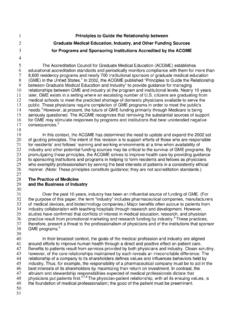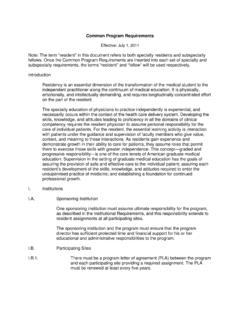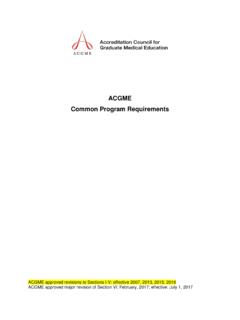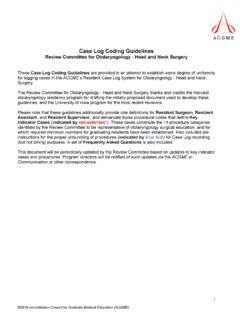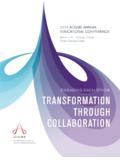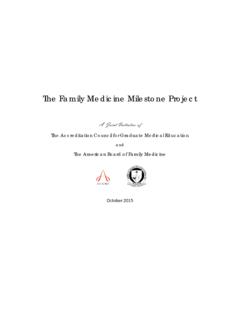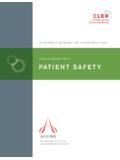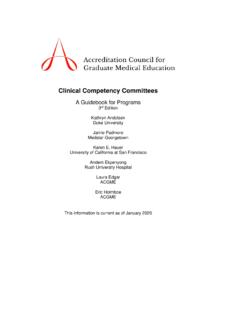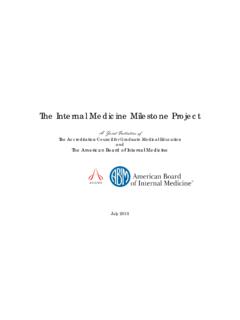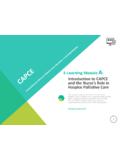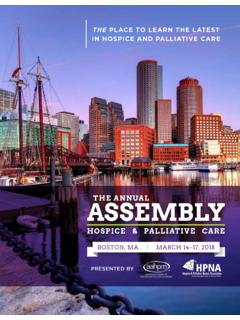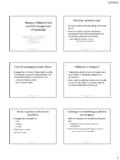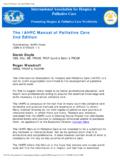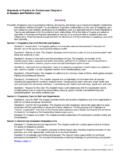Transcription of The Hospice and Palliative Medicine Milestones Project
1 The Hospice and Palliative Medicine Milestones Project A Joint Initiative of January 2015 milestone Reporting This document presents Milestones designed for programs to use in semi-annual review of fellow performance and reporting to the acgme . Milestones are knowledge, skills, attitudes, and other attributes for each of the acgme competencies that describe the development of competence from an early subspecialty learner up to and beyond that expected for unsupervised practice. In the initial years of implementation, the Review Committee will examine milestone performance data for each program s fellows as one element in the Next Accreditation System (NAS) to determine whether fellows overall are progressing. The Subspecialty Milestones are arranged in columns of progressive stages of competence that do not correspond with post-graduate year of education.
2 For each reporting period, programs will need to review the Milestones , identify those that best describe a fellow s current performance, and ultimately select a box that best represents the summary performance for that sub-competency (see the figure on page v). Selecting a response box in the middle of a column implies that the fellow has substantially demonstrated those Milestones , as well as those in previous columns. Selecting a response box on a line in between columns indicates that Milestones in the lower columns have been substantially demonstrated, as well as some Milestones in the higher column. A general interpretation of each column for subspecialty Medicine is as follows: Not Yet Assessable: This option should be used only when a fellow has not yet had a learning experience in the sub-competency. Critical Deficiencies: These learner behaviors are not within the spectrum of developing competence.
3 Instead they indicate significant deficiencies in a fellow s performance. Column 2: Describes behaviors of an early learner. Column 3: Describes behaviors of a fellow who is advancing and demonstrating improvement in performance related to Milestones . Ready for Unsupervised Practice: Describes behaviors of a fellow who substantially demonstrates the Milestones identified for a physician who is ready for unsupervised practice. This column is designed as the graduation target, but the fellow may display these Milestones at any point during fellowship. Aspirational: Describes behaviors of a fellow who has advanced beyond those Milestones that describe unsupervised practice. These Milestones reflect the competence of an expert or role model and can be used by programs to facilitate further professional growth. It is expected that only a few exceptional fellows will demonstrate these Milestones behaviors.
4 For each acgme competency domain, programs will also be asked to provide a summative evaluation of each fellow s learning trajectory. i Additional Notes The Ready for Unsupervised Practice Milestones are designed as the graduation target but do not represent a graduation requirement. Making decisions about readiness for graduation is the purview of the fellowship program director (see the FAQ Do you need to achieve a level of ready for unsupervised practice in each competency to receive credit for each year? in the Frequently Asked Questions document posted on the NAS section of the acgme website for further discussion of this issue). Study of milestone performance data will be required before the acgme and its partners will be able to determine whether the Ready for Unsupervised Practice Milestones and all other Milestones are in the appropriate stage within the developmental framework, and whether milestone data are of sufficient quality to be used for high stakes decisions.
5 Ii Listed below are the societies and members who have participated in the development of the Subspecialty Reporting Milestones being used for Hospice and Palliative Medicine . We thank the Alliance for Academic Internal Medicine (AAIM ) for their support of this effort. Chairs: Scott Gitlin, MD and John Flaherty, MD Accreditation Council of Graduate Medical Education: James Arrighi, MD; Susan Swing, PhD; Jerry Vasilias, PhD Alliance for Academic Internal Medicine : D. Craig Brater, MD; Margaret Breida; Kelly Caverzagie, MD; Gregory C. Kane, MD; Consuelo Nelson Grier; Polly Parsons, MD; Bergitta Smith American Academy of Hospice and Palliative Care Medicine : Laura Morrison, MD; Steven Radwany, MD; Timothy Quill, MD American Academy of Sleep Medicine : Vishesh Kapur, MD; Becky Roberts; Michael Silber, MB ChB American Association for the Study of Liver Diseases: Adrian Di Bisceglie, MD; Oren Fix, MD; Ayman Koteish, MD American Association of Clinical Endocrinologists: Pasquale Palumbo, MD; Dace Trence, MD American Board of Internal Medicine : Lee Berkowitz, MD; Eric Holmboe, MD; Sarah Hood; William Iobst, MD; Sharon Levin, MD; Sandra Yaich American College of Cardiology: Jill Foster; Marcia Jackson, PhD; Jeff Kuvin, MD; Eric Williams, MD American College of Chest Physicians: Doreen Addrizzo-Harris, MD; John Buckley, MD; Paul Markowski, CAE; Curtis Sessler, MD.
6 Kenneth Torrington, MD American College of Gastroenterology: Seth Richter, MD; Ronald Szyjkowski, MD American College of Physicians: Patrick Alguire, MD; Molly Cooke, MD American College of Rheumatology: Marcy Bolster, MD; Calvin Brown, MD American Gastroenterological Association: Tamara Jones; Lori Marks, PhD; Darrell Pardi, MD; Suzanne Rose, MD; Brijen Shah, MD American Geriatrics Society: Jan Busby-Whitehead, MD; Lisa Granville, MD; Rosanne Leipzig, MD American Society of Clinical Oncology: Frances Collichio, MD; Marilyn Raymond, MD; Jamie Von Roenn, MD American Society of Gastrointestinal Endoscopy: Diane Alberson; Walter Coyle, MD; Robert Sedlack, MD American Society of Hematology: Linda Burns, MD; Charles Clayton; Karen Kayoumi; Elaine Muchmore, MD American Society of Nephrology: Nancy Adams, MD; Raymond Harris, MD; Tod Ibrahim; Ryan Russell American Society of Nuclear Cardiology: Brian Abbott, MD; James Arrighi, MD American Thoracic Society: Henry Fessler, MD Association of Program Directors in Endocrinology, Diabetes and Metabolism: Ashok Balasubramanyan, MD; Ann Danoff, MD; Geetha Gopalakrishnan, MD Association of Pulmonary and Critical Care Medicine Program Directors: Craig Piquette, MD; David Schulman, MD Association of Specialty Professors: John Flaherty, MD; Mark Geraci, MD; Scott Gitlin, MD; Don Rockey, MD; Joshua Safer, MD Infectious Diseases Society of America: Wendy Armstrong, MD; Daniel Havlichek, Jr, MD Society of Cardiac Angiography and Interventions: Tarek Helmy, MD; Daniel Kolansky, MD Society of Critical Care Medicine : Stephen Pastores, MD; Antoinette Spevetz, MD The Endocrine Society: Beverly Biller, MD.
7 Ailene Cantelmi iii The diagram below presents an example set of Milestones for one sub-competency in the same format as the acgme Report Worksheet. For each reporting period, a fellow s performance on the Milestones for each sub-competency will be indicated by: selecting the column of Milestones that best describes that fellow s performance or, selecting the Critical Deficiencies response box Selecting a response box in the middle of a column implies Milestones in that column as well as those in previous columns have been substantially demonstrated. The fellow is in transition to the next level of development. Selecting a response box on the line inbetween columns indicates that Milestones in lower levels have been substantially demonstrated as well as some Milestones in the higher columns(s). iv Version 02/2014 Hospice and Palliative Medicine Milestones : acgme Report Worksheet 1.
8 Gathers and synthesizes essential and accurate information to define each patient s clinical problem(s). (PC1) Not Yet Assessable Critical Deficiencies Ready for unsupervised practice Aspirational Does not or is inconsistently able to collect accurate historical data Does not perform or use an appropriately thorough physical exam, or misses key physical exam findings Relies exclusively on documentation of others to generate own database or differential diagnosis or is overly reliant on secondary data Fails to recognize patient s central clinical problems Fails to recognize potentially life threatening problems Consistently acquires accurate and relevant histories Consistently performs accurate and appropriately thorough physical exams Inconsistently recognizes patient s central clinical problem or develops limited differential diagnoses Acquires accurate histories in an efficient, prioritized.
9 And hypothesis-driven fashion Performs accurate physical exams that are targeted to the patient s problems Uses and synthesizes collected data to define a patient s central clinical problem(s) to generate a prioritized differential diagnosis and problem list Obtains relevant historical subtleties, including sensitive information that informs the differential diagnosis Identifies subtle or unusual physical exam findings Efficiently utilizes all sources of secondary data to inform differential diagnosis Effectively uses history and physical examination skills to minimize the need for further diagnostic testing Role-models and teaches the effective use of history and physical examination skills to minimize the need for further diagnostic testing Comments: Copyright (C) Pending. The Accreditation Council for Graduate Medical Education and the American Board of Internal Medicine .
10 All rights reserved. The copyright owners grant third parties the right to use the Hospice and Palliative Medicine Milestones on a non-exclusive basis for educational purposes. 1 Version 02/2014 Hospice and Palliative Medicine Milestones : acgme Report Worksheet 2. Develops and achieves comprehensive management plan for each patient. (PC2) Not Yet Assessable Critical Deficiencies Ready for unsupervised practice Aspirational Care plans are consistently inappropriate or inaccurate Does not react to situations that require urgent or emergency care Does not seek additional guidance when needed Inconsistently develops an appropriate care plan Inconsistently seeks additional guidance when needed Consistently develops appropriate care plan Recognizes situations requiring urgent or emergency care Seeks additional guidance and/or consultation as appropriate Appropriately modifies care plans based on patient s clinical course, additional data, patient preferences, and cost-effectiveness principles Recognizes disease presentations that deviate from common patterns and require complex decision-making.
